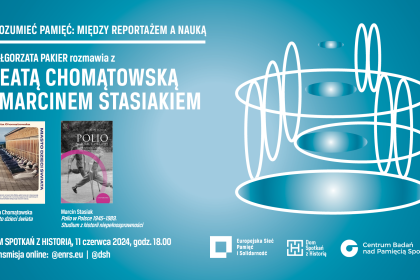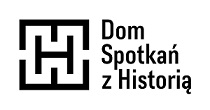Event in Polish [Polish version below]
11 June 2024, 6 PM
The discussion will take place at the Dom Spotkań z Historią in Warsaw and will be transmitted online.
The event will also be translated into Polish Sign Language.
Participants:
Beata Chomątowska, Miasto dzieci świata (City of children of the world)
Marcin Stasiak, Polio w Polsce 1945–1989. Studium z historii niepełnosprawności (Polio in Poland 1945-1989. A study of the history of disability)
Moderator: Małgorzata Pakier
In her reportage Miasto dzieci świata (City of children of the world), Beata Chomątowska deconstructs the idyllic image of the Rabka-Zdrój sanatorium. Reaching into the health resort’s past and the testimonies of participants, the journalist discovers hidden traumas that children have faced for decades behind the walls of the sanatorium.
In Polio w Polsce 1945–1989 (Polio in Poland 1945-1989), Marcin Stasiak addresses the disabilities caused by the polio epidemic, which affected mainly children in the 1950s. From an early age, sufferers were confronted with the fear that their disability caused, as well as the long and tiring process of questionable rehabilitation.
Chomątowska and Stasiak reflect on the everyday life of children with illnesses and how the disease - and the ‘treatment’ - shaped their lives. They both approach the subject from the perspective of the biographies of specific individuals and give voice to those who were previously deprived of it.
How does the reporter's narrative deal with personal experiences, and how are they described by the conceptual tools developed by social history? What does the past have to say about children and illness, and why is it worth talking about the subject from different perspectives?
Beata Chomątkowska is a journalist, writer and author of ‘Stacja Muranów’ (IStation Muranów) and ‘Betonia. Dom dla każdego’ (Betonia. A House for Everyone). Her work often deals with architecture, buildings and Warsaw.
Dr Marcin Stasiak is a member of the Theory of History Laboratory at the Jagiellonian University. His research focuses on the social and anthropological history of Poland after 1945.
Ph.D. Małgorzata Pakier is head of the academic department at the European Network Remembrance and Solidarity, co-creator of the Genealogies of Memory project and a graduate of the Polish School of Reportage.
___________________________
11 czerwca 2024, godz. 18.00
Wydarzenie odbędzie się w Domu Spotkań z Historią w Warszawie z transmisją online.
Spotkanie będzie tłumaczone na polski język migowy.
Wystąpią:
Beata Chomątowska, Miasto dzieci świata
Marcin Stasiak, Polio w Polsce 1945–1989. Studium z historii niepełnosprawności
Prowadzenie: Małgorzata Pakier
W reportażu „Miasto dzieci świata” Beata Chomątowska dekonstruuje idylliczny obraz sanatorium w Rabce-Zdroju. Sięgając do przeszłości uzdrowiska i świadectw uczestników turnusów, dziennikarka odkrywa skrywane traumy, z którymi od dziesięcioleci za murami sanatorium mierzyły się dzieci.
W pracy „Polio w Polsce 1945–1989” Marcin Stasiak podejmuje temat niepełnosprawności wywołanej przez epidemię polio, która dotknęła głównie dzieci w latach 50-tych. Już od najmłodszych lat chorzy byli konfrontowani ze strachem, jaki wywoływała ich niesprawność, a także z długim i męczącym procesem wątpliwej rehabilitacji.
Chomątowska i Stasiak zastanawiają się nad codziennością dzieci chorych i tym, jak choroba – i „leczenie” – wpłynęły na kształt ich życia. Oboje podchodzą do tematu z perspektywy biografii konkretnych osób i oddają głos tym, którym był on wcześniej odebrany.
Jak z osobistymi przeżyciami radzi sobie narracja reporterka, a jak opisują je narzędzia pojęciowe wypracowane przez historię społeczną? Co przeszłość ma do powiedzenia o dzieciach i chorobie, i dlaczego warto porozmawiać na ten temat z różnych perspektyw?
Beata Chomątkowska jest dziennikarką, pisarką, autorką m.in. „Stacja Muranów” i „Betonia. Dom dla każdego”. W swojej twórczości często zajmuje się architekturą, budowlami, Warszawą.
Dr Marcin Stasiak jest członkiem Pracowni Teorii Historii Uniwersytetu Jagiellońskiego. W swoich badaniach koncentruje się na historii społecznej i antropologicznej Polski po 1945 r.
Dr Małgorzata Pakier kieruje działem naukowym w Europejskiej Sieci Pamięć i Solidarność, jest współtwórczynią projektu Genealogie Pamięci i absolwentką Polskiej Szkoły Reportażu.
11 June 2024, 6 PM
The discussion will take place at the Dom Spotkań z Historią in Warsaw and will be transmitted online.
The event will also be translated into Polish Sign Language.
Participants:
Beata Chomątowska, Miasto dzieci świata (City of children of the world)
Marcin Stasiak, Polio w Polsce 1945–1989. Studium z historii niepełnosprawności (Polio in Poland 1945-1989. A study of the history of disability)
Moderator: Małgorzata Pakier
In her reportage Miasto dzieci świata (City of children of the world), Beata Chomątowska deconstructs the idyllic image of the Rabka-Zdrój sanatorium. Reaching into the health resort’s past and the testimonies of participants, the journalist discovers hidden traumas that children have faced for decades behind the walls of the sanatorium.
In Polio w Polsce 1945–1989 (Polio in Poland 1945-1989), Marcin Stasiak addresses the disabilities caused by the polio epidemic, which affected mainly children in the 1950s. From an early age, sufferers were confronted with the fear that their disability caused, as well as the long and tiring process of questionable rehabilitation.
Chomątowska and Stasiak reflect on the everyday life of children with illnesses and how the disease - and the ‘treatment’ - shaped their lives. They both approach the subject from the perspective of the biographies of specific individuals and give voice to those who were previously deprived of it.
How does the reporter's narrative deal with personal experiences, and how are they described by the conceptual tools developed by social history? What does the past have to say about children and illness, and why is it worth talking about the subject from different perspectives?
Beata Chomątkowska is a journalist, writer and author of ‘Stacja Muranów’ (IStation Muranów) and ‘Betonia. Dom dla każdego’ (Betonia. A House for Everyone). Her work often deals with architecture, buildings and Warsaw.
Dr Marcin Stasiak is a member of the Theory of History Laboratory at the Jagiellonian University. His research focuses on the social and anthropological history of Poland after 1945.
Ph.D. Małgorzata Pakier is head of the academic department at the European Network Remembrance and Solidarity, co-creator of the Genealogies of Memory project and a graduate of the Polish School of Reportage.
___________________________
11 czerwca 2024, godz. 18.00
Wydarzenie odbędzie się w Domu Spotkań z Historią w Warszawie z transmisją online.
Spotkanie będzie tłumaczone na polski język migowy.
Wystąpią:
Beata Chomątowska, Miasto dzieci świata
Marcin Stasiak, Polio w Polsce 1945–1989. Studium z historii niepełnosprawności
Prowadzenie: Małgorzata Pakier
W reportażu „Miasto dzieci świata” Beata Chomątowska dekonstruuje idylliczny obraz sanatorium w Rabce-Zdroju. Sięgając do przeszłości uzdrowiska i świadectw uczestników turnusów, dziennikarka odkrywa skrywane traumy, z którymi od dziesięcioleci za murami sanatorium mierzyły się dzieci.
W pracy „Polio w Polsce 1945–1989” Marcin Stasiak podejmuje temat niepełnosprawności wywołanej przez epidemię polio, która dotknęła głównie dzieci w latach 50-tych. Już od najmłodszych lat chorzy byli konfrontowani ze strachem, jaki wywoływała ich niesprawność, a także z długim i męczącym procesem wątpliwej rehabilitacji.
Chomątowska i Stasiak zastanawiają się nad codziennością dzieci chorych i tym, jak choroba – i „leczenie” – wpłynęły na kształt ich życia. Oboje podchodzą do tematu z perspektywy biografii konkretnych osób i oddają głos tym, którym był on wcześniej odebrany.
Jak z osobistymi przeżyciami radzi sobie narracja reporterka, a jak opisują je narzędzia pojęciowe wypracowane przez historię społeczną? Co przeszłość ma do powiedzenia o dzieciach i chorobie, i dlaczego warto porozmawiać na ten temat z różnych perspektyw?
Beata Chomątkowska jest dziennikarką, pisarką, autorką m.in. „Stacja Muranów” i „Betonia. Dom dla każdego”. W swojej twórczości często zajmuje się architekturą, budowlami, Warszawą.
Dr Marcin Stasiak jest członkiem Pracowni Teorii Historii Uniwersytetu Jagiellońskiego. W swoich badaniach koncentruje się na historii społecznej i antropologicznej Polski po 1945 r.
Dr Małgorzata Pakier kieruje działem naukowym w Europejskiej Sieci Pamięć i Solidarność, jest współtwórczynią projektu Genealogie Pamięci i absolwentką Polskiej Szkoły Reportażu.










